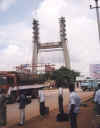 |
The suspension bridge being constructed across the
railway lines at KJM station. I was told that the bridge is being
constructed on such a grand scale as the erstwhile railway minister
Jaffer Sharrif wanted to make this a showpiece in his home turf.
The lines are located under the bridge span being hauled by a
crane. The lines to the left lead to SBC while to the right will
continue to Jolarpettai. |
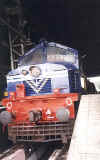 |
 |
An unknown Jumbo in the heavy overhaul section. The
section rear of the cab is stripped clean of equipment for
refurbishing, leaving only the bare frame. Reminded me of the
cartoon depiction of fish with the bare bones but with an intact
head. |
 |
 |
The second HHPDEMU rake in the Bangalore division.
This rake is stabled at the KJM loco shed pending
commissioning. |
 |
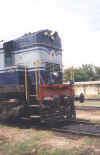 |
A typical KJM loco, the WDM 2C # 17902R (R for
rebuilt by DCW - Patiala). As this is a WDM 2 C, note the lack of
sand boxes in the short hood (no square holes near the driver's
windscreen) or and in long hood (no square holes on both sides of
the radiator room door). More explanation below. |
 |
A standard feature of the WDM 2C, WDG 2, WDP 2 and
the WDM 2 (rebuilt) locos is the cyclone air filter - this needs a
blower motor which can be seen below the frame. Also visible is the
sand box which has been removed from the body to the bogie in case
of the WDM 2C (rebuilt or new), WDG 2 and the WDP 2 but NOT the
plain WDM 2 (rebuilt). Note the clean long hood and short hood of
the above pictures - instant identification of a C variant for the
confused IR enthusiast. More pics later in the page to show the
location of the sand boxes in a standard WDM 2. |
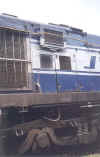 |
The screen of the cyclone air filter. The
compressed air from the underframe blower is led (via the bent pipe
on the catwalk) to this screen. I do not have a clear idea of the
advantages of the cyclone filter over the conventional air filter
but an increasing number of locomotives are using these air
cleaners. The C variant also has a different turbocharger (GE, ABB
or Napier) and that results in a flatter (but larger) exhaust stack
visible on the top of the roof. |
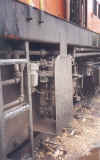 |
Another important modification on the newer locos
is this sophisticated drier which removes moisture from the
compressed air supply. This part (seen on a WDG 2) makes an
explosive sound every few minutes when it discharges the trapped
water on the ground. |
 |
The rest of the visiting Gooty WDG 2A # 14924 which
is MUed with another GY power, the WDG 2 # 14891. The A variants
are supposed to be only Air brakes, however this loco has a vacuum
brake pipe also. On the other hand the A variant in the new locos
could mean the ones with dual brakes ! The dual brake version of
the WDP 2 is also called the WDP 2A. Some WDG2s from Pune are being
converted for dual brake operation from pure air brakes as there is
quite some vacuum braked stock left. Why is this loco provided with
a 'transition coupler' ? This is the clevis arrangement in the CBC
which is used to interface with hook or screw coupler coach/wagon -
one hopes with a passenger stock for I would like to be hauled by
these powerhouses some day ! |
 |
Another look at the WDG 2 pair at KJM shed.
Increasing number of WDG 2s are being christened "Shakti" (power) -
this is a generic name for all the WDG 2s. However the WDG 2s have
been referred in the past as "Shaktiman" (powerful) or as "Gajraj"
(elephant king). The last name could have been specific to the
earlier version of the loco with a balding forehead (baldie) short
hood. |
 |
 |
The WDG 2 pair from the side. Note the high
adhesion bogies. The driver in a WDG 2 sits on the left hand side
(in the direction of the travel) and hence the doors and the
windscreens are also reversed as compared to a standard WDM 2. |
 |
 |
More pics of the WGD 2s with a detailed view of the
'Shakti' name. |
 |
 |
General views of the KJM loco shed. |
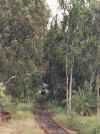 |
A loco having a bath in the washing facility of KJM
shed. |
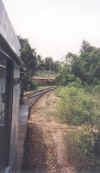 |
 |
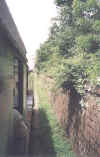 |
We finish the work at KJM shed of checking the second HHPDEMU
rake and hitch a ride on the WDM 2C # 17902R to the KJM station.
The shed is at a lower level and any loco exiting has to climb a
ramp till the level of the SBC Chennai line at the higher
level. |
 |
 |
KJM WDM 2C # 17902R and Erode (ED) WDM 2 # 17703
wait at the KJM station. The sandbox for the rear truck (bogie) are
clearly visible on the either side of the radiator room door on the
ED power. Compare this to the clean long hood of the WDM 2C 17902R
whose sand boxes are removed to the bogies. In case of the short
hood, the standard WDM 2 has the sandboxes near the crew's forward
windscreens. |
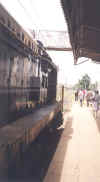 |
One curious feature of some of the rebuilt WDM 2Cs
is the centrifugal lube oil filter, for which there is no space
inside the engine room. This is a problem in locos with a GE
turbocharger whose aftercooler is larger. Hence one of the doors is
bulged to accommodate the extra filter. This somewhat obstructs the
driver's line of vision when working long hood leading. |

























to this page